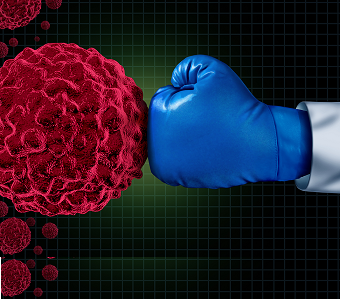Infinity Pharmaceuticals (INFI) lost more than two-thirds of its market value, or $1.6 billion last year after Phase 1 data presented at the June 2013 ASCO meeting revealed toxicity issues with use of its lead asset, IPI-145, in blood cancer patients. Now, an enterprise value of $276.2 million suggests investors hold out little hope that the Cambridge, MA-based biotech can establish a meaningful presence in an increasingly competitive space in the treatment of Beta-cell malignancies such as non-Hodgkin’s lymphoma (NHL) and sub-populations.
A précis of Infinity’s stumble is briefly covered in a prior PropThink article, dated June of 2013: in a dose-escalation and safety trial of IPI-145, a Class I PI3K delta/gamma inhibitor, across a broad range of hematologic malignancies –including CLL (chronic lymphocytic leukemia), multiple myeloma (MM), iNHL (indolent non-Hodgkin’s lymphoma), aNHL (aggressive non-Hodgkin’s lymphoma), and MCL (mantle cell lymphoma) – promising efficacy was overshadowed by a higher rate of serious adverse events, including hepatic toxicity concerns (elevated liver enzymes) and two deaths due to respiratory infections (pneumonia/pneumonitis).
The genesis of investors’ perturbations: whether or not the deaths could be linked directly to IPI-145’s specific mechanism of action.
Phosphatidylinositol 3-kinases (PI3Ks) are a family of enzymes that regulate diverse cellular functions, including proliferation, differentiation, immune response, and apoptosis. PI3K is now recognized as an attractive molecular target for novel anti-cancer molecules because aberrantly activated isoforms are preferentially over-expressed in leukocytes (white blood cells). Therefore, it’s been hypothesized that inhibition of these isoforms may have therapeutic potential across a broad range of blood cancers (and inflammatory diseases).
To date, three Class I PI3K isoforms have been implicated in tumorogenesis: PI3K-alpha, PI3K-delta, and PI3K-gamma. Given each isoform uniquely affects the PI3K signaling oncogenic pathway (different MOA), isoform-specific PI3K inhibition likely results in different side-effect profiles too.
And therein lay the rub: IPI-145 is a dual potent, oral inhibitor of Class I PI3K-delta and PI3K-gamma. Observations from early clinical data in iNHL and CLL patients treated with IPI-145 suggest greater inhibition of malignant cell growth compared to treatment with molecules selective for only PI3K-delta or PI3K-gamma – broadening the drug’s potential hematologic treatment profile and commercial value. However, PI3K-gamma also plays an integral role in immune response. Ergo, it’s thought that IPI-145 may play a role in weakening a patient’s immune system via this gamma inhibition too.
However, a retrospective analysis of the ASCO 2013 data strongly suggested that the trial design and existing health of enrolled patients played an integral role in the serious adverse-events reported. Study participants – all of whom had advanced blood cancers (such as relapsed/ refractory CLL or R/R iNHL) and had undergone several courses of previous immunosuppressive oncology therapies – did not receive prophylactic treatments prior to enrollment: thus, making them far more likely to contract life-threatening hematologic and respiratory infections.
Evolving Phase 1 data presented at the American Society of Hematology (ASH) meeting held in early December 2013 showed not only IPI-145’s earlier safety concerns had been overblown, but that the drug demonstrated impressive efficacy in patients with either relapsed or refractory CLL (81% of patients had been treated with three or more systemic therapies), too:
o Given routine antibiotics (to ward off potential respiratory infections), the vast majority of adverse events were asymptomatic and reversible (despite more than 40% of patients in the expansion cohorts, receiving either 25mg or 75mg twice-daily, signing on with grade-3 or higher cytopenias at baseline).
o Additionally, of 47 evaluable patients with relapsed or refractory CLL, 1 had a complete response, 21 had a partial response, 24 had stable disease, and only one had disease progression. The overall response rate was 47%.
Infinity has two potential registration studies underway: a Phase 2 clinical trial to evaluate the safety and efficacy of IPI-145 as a monotherapy in subjects with iNHL (“DYNAMO”); a Phase 3 clinical trial to examine the efficacy of IPI 145 monotherapy versus ofatumumab monotherapy (the anti-CD20 monoclonal antibody sold by GlaxoSmithKline (GSK) under the trade name Arzerra) in subjects with relapsed or refractory CLL (called “DUO”) – and plans to initiate a Phase III randomized placebo-controlled study of IPI-145 in combination with Roche’s (RHHBY) top-selling anti-CD20 monoclonal antibody Rituxan (rituximab) in patients with relapsed INHL (“Dynamo +R”).
Still, investors remain indifferent to these transformative R&D activities.
Credibility and timing are the anchors to Infinity’s stock price: there are at least 15 Class I PI3K drugs in development (as of October 2013), including Swiss-based Rhizen Pharmaceuticals’ dual PI3K delta/gamma inhibitor, RP6530; Amgen’s (AMGN) PI3K delta inhibitor, AMG-319; Roche’s dual alpha/gamma inhibitor, called pictilisib; and, Onconova Therapeutics’ (ONTX) dual cellular signaling pathway inhibitor, called rigosertib, which blocks PI3K and PLK (a protein kinase that plays a critical role in monitoring chromosomes during cell division).
Though the clinical development of IPI-145 is (at least) 12-months ahead of most rivals, developmental delays in 2013 meant the drug lost its first-in-class status to Gilead Sciences’ (GILD) idelalisib: with new drug applications accepted by the FDA for the treatment of iNHL and CLL, GILD’s PI3K-delta inhibitor will likely be first-to-market come 2015.
The Leukemia & Lymphoma Society estimates that approximately 28,000 and 15,680 people were diagnosed with iNHL and CLL in 2013. Despite these numbers, competition from established treatments like patient-share leader Rituxan, Pharmacyclics’ (PCYC) Imbruvica (the small molecule ibrutinib, which targets an enzyme, Bruton’s tyrosine kinase (BTK), overexpressed in a variety of B-cell cancers), and a host of other approved and investigational targeted therapies means – contrary to management’s expressed hopes for accelerated approval – Infinity may encounter delays in finding available candidates sufficient to fulfill enrollment targets for its announced clinical trials.
For example, the DUO Phase 3 study (IPI-145 vs. Arzerra in CLL) could find it difficult to even enroll qualified candidates, as GlaxoSmithKline only received U.S. regulatory approval for this indication just last November. Puzzling, too, that Infinity designed its trial against this anti-CD20 monoclonal inhibitor: Approved in the EU since 2009, global sales in 2013 totaled an anemic $127.5 million – which suggests EU enrollment could be just as slow.
Investors are likely punishing INFI’s stock price, knowing that each delay pushes any IPI-145 hematologic cancer launch out to 2016 – 2017.
In addition, these delays will give Gilead sufficient time to entrench idelalisib as the preferred oral PI3K for relapsed or refractory NHL or CLL in the minds of hematologists and oncologists. And, short any direct head-head study with idelalisib, it will prove difficult for INFI to market and to differentiate IPI-145 – as comparable efficacy will remain suspect.
Still, given the growing prevalence of both CLL and NHL (as patients live longer) and a continuing unmet need – evidence suggests there is a strong selective pressure showing malignant Beta-cancer cells mutate and acquire specific kinase resistance, even with Rituxan – room remains for IPI-145 to be a viable player in the lymphoma market, either as mono- or in combination therapy.
Global analytics researcher Decision Resources forecasts the NHL market will exceed $10 billion in annual sales in the G7 nations by 2022. As patients live longer, the immutable fact remains this forecast could prove conservative – suggesting that should IPI-145 prove to be as efficacious as the early data suggests, investors may be underestimating the commercial prospects of a drug that will likely sell for more than $100,000 per patient treatment year.
Sure, it’s reasonable to totally discount any role for the PI3-kinase platform as a viable inflammation franchise – as proof-of-concept and limited efficacy data do little to attract investor confidence to an already-crowded rheumatoid arthritis market dominated by Roche’s and Bristol-Myers Squibb’s (BMY)TNF-alpha inhibitors Rituxan and Orencia (with multiple indications & acceptable post-marketing surveillance data) and up-and-coming oral JAK inhibitors, like Pfizer’s (PFE) Xeljanz.
Infinity’s market cap of $480 million also implies little worth to IPI-145’s commercial potential in cohorts of other blood cancers, such as T-cell lymphomas. According to the National Cancer Institute, in the U.S. alone there were an estimated 530,919 people living with non-Hodgkin lymphoma in 2011 – which means about 79,637 patients with blood cancers of T-cell origin (15% of NHL). Assuming even just a 5% market penetration, the annual sales of IPI-145 could total more than $398 million annually in the U.S.
Nonetheless, I suspect the only real catalyst capable of driving INFI shares this year would be an announced collaborative partnership. Management says it plans to go it alone in developing its PI3-kinase blood cancer franchise. With approximately $314 million in available liquidity ($214M in cash and $100M credit line) and a 2014 forecasted cash burn of $170 million – $180 million, the company can continue fronting this feted legerdemain until the second half of 2015 (when it will need to access new financing).
Patient investors who believe there is more to INFI’s PI3-kinase platform than proof-of-concept could be handsomely rewarded down the line, as any positive (interim) duration of response data coming from the iNHL trial should give INFI the leverage it needs (and is likely looking for) to extract better milestone and royalty terms from a potential partner.




